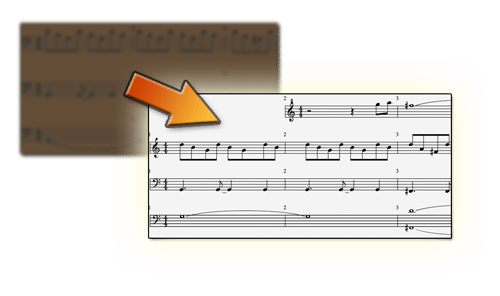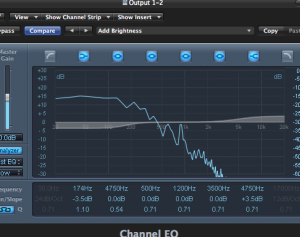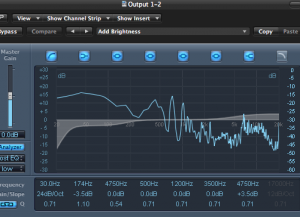In the studio, frequency training seems almost intuitive. You may not know why your track sounds better with some deep bass, an added high-pitched synthesizer, or even a thinner texture, but you do know that your music can go from average to awesome after a few minor tweaks.
Don’t depend on trial-and-error! Train your ears to hear frequency.
(Need a quick primer on audio, frequency, EQ, etc.? Try the Frequency Fundamentals series or our EQ and mixing topic pages.)
Learn how to improve your mix below as we take a simple music sketch and improve it using common frequency-mixing tricks. Test your ear training skills. Listen for octaves, frequency, pitch and texture. Then use the great tips below in your own music.
“Frequency Basica” version 1: The Sketch
There are lots of problems with version 1 of our track “Frequency Basica” (besides a lack of originality!)
Using your ears, you can hear that this track is pretty “muddy”.
Now what does “muddy” really mean?
It means that the track lacks clarity.
And why does this track lack clarity? Listen to the track again, and then look over the score and frequency analysis below.
This track commits two mixing errors directly based on frequency:
- Every instrument, even the drums, is a low-pitched instrument. If you look at the graph, you see that this track’s frequencies increase exponentially under 500 Hz, then drop off well before 1kHz, leaving a lack of clarity, too much boom, and little definition.
- The track has too much overlap. If you aren’t familiar with the concept of overlap, check out the article “Introduction to Frequency Training”. In a musical nutshell, when you look at the score, you see that the instruments are competing for the same frequency real estate. And in this case, everyone loses.
Fortunately there are quite a few easy fixes for these types of issues which we’ll look at below. These issues can arise with a synthesized track or a live mix. While Version 1 here is mixed in Logic, a live acoustic mix will have some of its own challenges and advantages but many of these kinds of frequency tweak will work about the same in the live environment.
Version 2: Octave Fun
Listen to the revised version of the sample track. As you listen, use your listening skills to pick out the following:
- Increased frequency range in the track as a whole
- Octave changes in the different musical parts
- Frequency-related changes in the percussion track
- Octave placement of the added melody line
- How the muddiness/clarity of Version 2 compares with Version 1
This revised version benefits incredibly by moving all of the parts out of each other’s way.
Imagine the different instruments (bass, strings, keys, and percussion) like a family dinner where ten of your favorite relatives are all expected to sit at a table which seats only four. The instruments are busy elbowing each other and fighting for attention! Spread the instruments out and give them space (as much space as you give that one crazy uncle that never wears deodorant!)
In the live setting, you could ask a band member to play an octave higher, or change to an instrument with a different timbre and range (e.g. trading an acoustic guitar for a ukulele, or bongos for a low-pitched djembe). Since the singer is central in many styles of music, opt for altering the range of the instruments before asking your singer to transpose their melody.
BONUS TIP: Sometimes you do want to start clustered in a particular register, and then slowly expand the pitch range of the track to add depth – or purposely leave wide frequency holes to “open up” a track.
When you see this simple score, the first thing you notice is that instruments are now spaced farther apart and that we have added a simple melodic line. The melodic line is loosely based on a simplified version of the bass line, placed octaves higher, with a few added passing notes.
Sometimes I find that a simple melody, counter melody, or harmony in a different octave will add just what I need for a little more interest in the track. After all, loops and repeated chords are monotonous. And monotony = BORING!
Some of the string pad notes still lie in the same register as the bass line, but as the track continues, the strings widen their reach, eventually hitting some high notes near the end. Climbing up octaves like a ladder is a great way to easily build-up excitement in a track. Build depth in your music by climbing up as you maintain some of the notes in the low to middle registers.
Now you can see that the track expands beyond the 500 Hz range. Because there is peaking around 1-2khz, the track has a certain clarity and perceived loudness that fights the muddiness from the sketch version. A little EQ tweaking chops off some of the really low-end frequencies to keep boom to a minimum.
The percussion track has also had an entire overhaul. While most musicians think about percussion and drums in terms of rhythm and beats, as a percussionist I know that a properly placed high-hat rhythm or a solid bass hit can fill in the frequency and pitch holes in a track. In this case I replaced the simple four beat pattern with a complicated loop that includes cymbals, high hats, and electronic sounds that provide some interesting changes and textures.
Version 3: Final Frequency Tweaks
Promoting instruments’ sounds involves more than simply mixing. If you use your ear training skills in frequency and pitch, you can change guesswork into informed decisions.
Most of the changes in Track 3 involve pulling out specific instruments in order to emphasize specific registers. Hitting the delete or mute button adds some interest, spacing, and musical form to the track.
Some of these tweaks involved manipulating the 8th note keys part further and creating almost a scale-like climb and descent in the line through octave changes, culminating in a simultaneous climb and descent at the end:
I pulled out the heavy percussion at the beginning, giving the slightly altered bass line and melody a chance to shine before the complicated percussion part fills in the gaps with the string pad. Other changes in the percussion line were made specifically with pitch in mind.
Use your ears to hear:
- How the change in percussion alters the sound of the track (ex. high-pitched synth sounds and the low-pitched bass drum).
- A broader pitch range, especially in the keys part.
- How creating frequency holes in the track changes the texture and sound of the track.
Finally, compare Version 3 to the original Sketch version. Compare the two versions and use your ear training skills to hear how paying attention to frequency and pitch can enhance a track:
Recap
- Avoid muddiness in a track by expanding the pitch range, avoiding overlap, and including higher pitch ranges.
- Create space in your music by pulling out frequencies.
- Fill in frequency gaps with the percussion section.
- Experiment with jumping octaves and changing instruments.
- Add extra parts in different ranges like countermelodies, additional melodies, and accents.
- Fill out your music by expanding the overall pitch range of your track.
- Train your ears to hear frequency issues in your music.
- Add interest to your track by experimenting with octaves.
We want to hear from you! Share your own mixing tips and frequency questions in the comments below. Are there problems that plague your mixing efforts which you’d like us to cover next time?














Have you seen the new Kitara? Basically, it's a brand new, innovative way to create electronic music. Guitarist can now expand their portfolio and start using a guitar synthesizer to create all kinds of new sounds. Be sure to check it out.